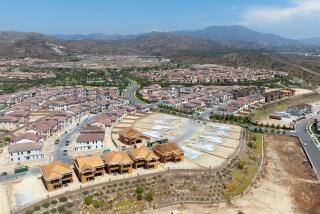Study: El Toro Airport Noise Won’t Be Problem
The county’s scaled-back airport plan for El Toro would concentrate the greatest noise from commercial flights over undeveloped land, rather than existing homes and schools, according to a new report that county officials released Tuesday.
Opponents of a commercial airport at El Toro said the report still showed unacceptable levels of noise over residential areas such as Leisure World, and that the study was based on assumptions about arrival and takeoff paths that are likely to change.
The report presents a new noise “footprint” for El Toro based on a plan approved by the Board of Supervisors in April for an airport serving 24 million passengers a year by 2020.
Earlier studies contemplated a larger high-noise area for a 33.5-million passenger airport that was rejected by supervisors.
“The bottom line is that the vast majority of Orange County’s 2.6 million residents, north and south, will experience little or no noise from the new airport,” said Courtney Wierchioch, program manager for the El Toro base reuse project.
According to the report, most of the highest-level noise would occur within a 14,000-acre buffer zone around the Marine Corps Air Station that has been kept clear of noise-sensitive developments such as homes and schools. State law restricts what can be built within areas where average noise levels exceed 65 decibels.
The closest neighborhood to the airport, Leisure World in Laguna Hills, would be hit with the most noise, the study showed, with an average 64 decibels outdoors--just under the level where state restrictions kick into gear. By comparison, conversation occurs at 60 decibels; a vacuum cleaner operates at 70 decibels.
El Toro airport foes argued that even at 60 decibels or less, airport noise would have a harmful effect on residents, especially the elderly and schoolchildren.
Laguna Hills Councilman Allan Songstad, a member of the anti-airport El Toro Reuse Planning Authority, said South County definitely will be affected by the airport, not only with noise and air pollution but by flights zooming overhead every three to six minutes.
“They’re trying to sell this as a good-neighbor use and it’s not,” Songstad said.
County officials are accepting comments until 5 p.m. Dec. 18 on the types of issues that should be studied in the environmental report for the proposed airport.
The Marines are scheduled to leave the 4,700-acre base in July and convey the property to the county sometime in 2000. A countywide vote in 1994 designated the property for a commercial airport and airport-related uses.
The study averaged noise from a mix of aircraft types that will use the airport after its expected opening date in 2005, with a sampling of anticipated destinations. It also took into account a greater noise impact from night flights.
The analysis predicted that 45% of flights--mostly those by narrow-body aircraft--would depart to the east, while about half of the flights--those using wide-body jets--would leave to the north over undeveloped property between the base and Anaheim Hills.
Planes would land from the south over Aliso Viejo and Laguna Hills.
Rancho Santa Margarita, about six miles from the runways, would be the first neighborhood to the east to hear departing jets, noise consultant Vince Mestre said. East Anaheim residents about 12 miles from El Toro would be the first to hear takeoffs to the north, he said.
The county’s technical consultants said nearby hills and wind conditions posed no significant problems for jets taking off, which airport foes have disputed, saying pilots complain about taking off over hills. Fully loaded planes could fly nonstop as far as Hong Kong and Singapore without problems, Wierchioch said.
The study also estimated that the noise area around John Wayne Airport would grow slightly by 2020. The preferred El Toro airport plan approved by supervisors includes a slight increase in jet traffic at John Wayne Airport, with shorter flights using that airport and longer, plus international, flights using El Toro.
The county’s consultants insisted that the information presented Tuesday assumed a future airport operating without any noise restrictions, including a night-time flight curfew.
The Board of Supervisors is on record pledging to push for a curfew and other measures to make the airport more acceptable to its neighbors, Wierchioch said.
All of the county’s proposed measures to mitigate noise and other impacts will be included in an environmental document that should be available in draft form in the spring. The final environmental report should be available by December 1999.
(BEGIN TEXT OF INFOBOX / INFOGRAPHIC)
Quiet Neighbor?
The latest El Toro noise study contends that no homes or schools will be affected by unacceptable noise levels if El Toro Marine Corps Air Station were turned into a commercial airport.
According to the MCAS study, communities around the airport will be exposed to noise below the 65-decibel limit.
Leisure World: 64
Aliso Viejo: 62
R. Santa Margarita: 59
Lake Forest: 57
Monarch Beach: 56
Anaheim Hills: 55
Northwood: 53
Coto de Caza: 51
*--*
Airport Residences People Schools El Toro International 0 0 0 John Wayne Airport 120 300 0 Los Angeles International 31,335 84,054 36* Seattle Tacoma International 13,620 31,800 28 San Francisco International 1,360 5,900 n/a
*--*
*Total schools estimated from land use map; 1 not insulated; 35 are sound insulated
Source: County of Orange
More to Read
Sign up for Essential California
The most important California stories and recommendations in your inbox every morning.
You may occasionally receive promotional content from the Los Angeles Times.









